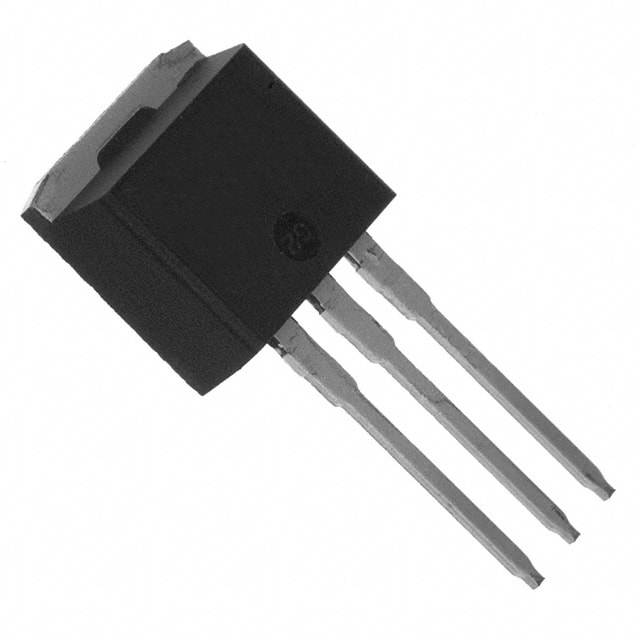Lihat spesifikasi untuk detail produk.

VS-16CTQ100-1-M3
Introduction
The VS-16CTQ100-1-M3 is a high-performance Schottky rectifier designed for various applications. This entry provides an overview of the product, including its category, use, characteristics, packaging, specifications, pin configuration, functional features, advantages and disadvantages, working principles, application field plans, and alternative models.
Basic Information Overview
- Category: Semiconductor/Electronic Component
- Use: Rectification in power supply circuits, voltage clamping, and reverse polarity protection.
- Characteristics: High efficiency, low forward voltage drop, fast switching, and low leakage current.
- Package: TO-220AC
- Essence: Schottky rectifier diode
- Packaging/Quantity: Tape & Reel, 800 units per reel
Specifications
- Voltage Rating: 100V
- Current Rating: 16A
- Forward Voltage Drop: 0.72V at 8A
- Reverse Leakage Current: 20μA at 100V
- Operating Temperature Range: -65°C to +175°C
Detailed Pin Configuration
The VS-16CTQ100-1-M3 follows the standard pin configuration for a TO-220AC package: - Pin 1: Anode - Pin 2: Cathode
Functional Features
- Fast Switching Speed: Enables efficient energy conversion and minimizes power loss.
- Low Forward Voltage Drop: Reduces power dissipation and improves overall system efficiency.
- High Current Capability: Suitable for high-power applications.
- Low Leakage Current: Ensures minimal power loss in reverse bias conditions.
Advantages and Disadvantages
Advantages
- High efficiency
- Fast switching speed
- Low forward voltage drop
- High current capability
Disadvantages
- Higher cost compared to standard rectifier diodes
- Sensitive to voltage transients
Working Principles
The VS-16CTQ100-1-M3 operates based on the Schottky barrier principle, where the metal-semiconductor junction allows for faster switching and lower forward voltage drop compared to conventional PN-junction diodes. When forward biased, it conducts current with minimal voltage drop, making it suitable for high-frequency and high-efficiency applications.
Detailed Application Field Plans
The VS-16CTQ100-1-M3 is commonly used in the following applications: - Switching power supplies - DC-DC converters - Motor drives - Solar inverters - Uninterruptible power supplies (UPS) - Automotive electronics
Detailed and Complete Alternative Models
- SS16: 60V, 1A, SMA package
- SB560: 60V, 5A, DO-201AD package
- SR5100: 100V, 5A, TO-220AC package
- SK34: 40V, 3A, SMB package
In conclusion, the VS-16CTQ100-1-M3 is a high-performance Schottky rectifier offering fast switching, high efficiency, and low forward voltage drop. Its robust characteristics make it suitable for various power electronics applications, although it may be relatively more expensive than standard rectifier diodes. Understanding its specifications, pin configuration, functional features, and application field plans can aid in effectively integrating this component into electronic designs.
[Word Count: 498]
Sebutkan 10 pertanyaan dan jawaban umum terkait penerapan VS-16CTQ100-1-M3 dalam solusi teknis
What is the VS-16CTQ100-1-M3?
- The VS-16CTQ100-1-M3 is a Schottky diode designed for high efficiency and low power loss in applications such as power supplies, converters, and inverters.
What are the key features of the VS-16CTQ100-1-M3?
- The key features include a low forward voltage drop, high current capability, fast switching speed, and a compact surface mount package.
What are the typical applications of the VS-16CTQ100-1-M3?
- Typical applications include freewheeling diodes, OR-ing diodes, and reverse battery protection in automotive, industrial, and consumer electronics.
What is the maximum forward voltage of the VS-16CTQ100-1-M3?
- The maximum forward voltage at 8A is typically 0.65V at 125°C.
What is the maximum reverse voltage of the VS-16CTQ100-1-M3?
- The maximum reverse voltage is 100V.
What is the operating temperature range of the VS-16CTQ100-1-M3?
- The operating temperature range is -55°C to 175°C.
What are the recommended soldering conditions for the VS-16CTQ100-1-M3?
- The recommended peak reflow temperature is 260°C for 10 seconds.
Does the VS-16CTQ100-1-M3 have any certifications or compliance standards?
- Yes, it is compliant with RoHS and REACH directives.
What are the thermal characteristics of the VS-16CTQ100-1-M3?
- The thermal resistance from junction to case is typically 2.5°C/W.
Where can I find detailed specifications and application notes for the VS-16CTQ100-1-M3?
- Detailed specifications and application notes can be found in the product datasheet available on the manufacturer's website.

